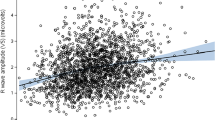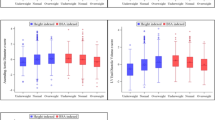Abstract
Accurate reference ranges for measurements from echocardiography rely on an understanding of the distribution of each measurement in the diverse, multi-racial world population. The aim of this study was to determine the influence of gender, age and ethnicity on common echocardiographic measures of the left heart, and to evaluate the effect of different methods of indexation on measurements from healthy, non-Caucasian populations. Standard echocardiographic measurements of left heart size and left ventricular mass (LVM) were assessed in 341 healthy volunteers. Indexation was performed using height, body surface area, and fat free mass (FFM). Quantile regression was used to derive age-adjusted values at the 5th, 50th and 95th ‰ of each measurement, by gender, within Caucasians. The effect of indexation method across ethnic groups could then be compared. Indexation of m-mode dimensions may overcompensate for body size, resulting in people of smaller build (women and those of South or East Asian descent) developing higher indexed values than those of larger build (men and people of Maori or Pacific descent). Indexation of 2D volumes by any method improves the integration of values across ethnic groups, with FFM yielding the greatest integration. LVM increases with age, suggesting that the static reference values currently recommended for this measurement may not be appropriate. There are important differences in the distribution of measurements of left heart size by gender, ethnicity and age.



Similar content being viewed by others
References
Dewey FE, Rosenthal D, Murphy DJ Jr, Froelicher VF, Ashley EA (2008) Does size matter? Clinical applications of scaling cardiac size and function for body size. Circulation 117(17):2279–2287. doi:10.1161/circulationaha.107.736785
Rush EC, Freitas I, Plank LD (2009) Body size, body composition and fat distribution: comparative analysis of European, Maori, Pacific Island and Asian Indian adults. Br J Nutr 102:632–641
Lang RM, Bierig M, Devereux RB, Flachskampf FA, Foster E, Pellikka PA, Picard MH, Roman MJ, Seward J, Shanewise JS, Solomon SD, Spencer KT, St John Sutton M, Stewart WJ (2005) Recommendations for chamber quantification: a report from the American Society of Echocardiography’s guidelines and standards committee and the Chamber Quantification Writing Group, developed in conjunction with the European Association of Echocardiography, a branch of the European Society of Cardiology. J Am Soc Echocardiogr 18(12):1440–1463
Whalley G, Gamble G, Doughty R, Culpan A, Plank L, MacMahon S, Sharpe N (1999) Left ventricular mass correlates with fat-free mass but not fat mass in adults. J Hypertens 17:569–574
Drazner MH, Dries DL, Peshock RM, Cooper RS, Klassen C, Kazi F, Willett D, Victor RG (2005) Left ventricular hypertrophy is more prevalent in blacks than whites in the general population. Hypertension 46(1):124–129
Du Bois D, Du Bois E (1916) Clinical calorimetry: a formula to estimate the approximate surface area if height and weight be known. Arch Intern Med XVII(6_2):863–871
Bella JN, Devereux R, Roman MJ, O’Grady MJ, Welty TK, Lee ET, Fabsitz RR, Howard BV (1998) Relations of left ventricular mass to fat-free and adipost body mass: the Strong Heart Study. Circulation 98:2538–2544
De Simone G, Devereux R, Palmieri V, Bella JN, Oberman A, Kitzman DW, Hopkins PN, Rao DC, Arnett DK (2003) Influence of fat-free mass on detection of appropriateness of left ventricular mass: the HyperGEN study. J Hypertens 21:1747–1752
R Development Core Team (2010) R: a language and environment for statistical computing, 2.12.0 edn. The R Foundation for Statistical Computing, Vienna
Koenker R (2013) Quantreg: quantile regression,R package version 4.97. http://CRAN.R-project.org/package=quantreg
De Simone G, Daniels S, Devereux R, Meyer R, Roman MJ, De Divitiis O, Alderman MH (1992) Left ventricular mass and body size in normotensive children and adults: assessment of allometric relations and impact of overweight. J Am Coll Cardiol 20(5):1251–1260
Chirinos J, Segers P, De Buyzere M, Kronmal R, Raja M, De Bacquer D, Claessens T, Gillebert T, St John-Sutton M, Rietzschel E (2010) Left ventricular mass: allometric scaling, normative values, effect of obesity, and prognostic performance. Hypertension 56:91–98
Wang Z, Zhang J, Ying Z, Heymsfield SB (2012) New insights into scaling of fat-free mass to height across children and adults. Am J Hum Biol 24:648–653
Thomson R, Brinkworth G, Buckley J, Noakes M, Clifton P (2007) Good agreement between bioelectrical impedance and dual-energy X-ray absorptiometry for estimating changes in body composition during weight loss in overweight young women. Clin Nutr 26:771–777
Vasan RS, Larson MG, Levy D, Evans JC, Benjamin EJ (1997) Distribution and categorization of echocardiographic measurements in relation to reference limits: the Framingham Heart Study: formulation of a height- and sex-specific classification and its prospective validation. Circulation 96(6):1863–1873
Vasan RS, Levy D, Larson MG, Benjamin EJ (2000) Interpretation of echocardiographic measurements: a call for standardization. Am Heart J 139(3):412–422
Acknowledgments
We gratefully acknowledge our colleagues who assisted with recruitment and assessment of these subjects: James Aoina, Phillipa Cross, Kristin Feldmann, Aidan Gill, Malcolm Legget, Adele Pope, Ralph Stewart, Cara Wasywich. The Heart Foundation of New Zealand supported this study with a contestable research grant and individual support through a postgraduate scholarship and a research fellowship (K.K.P.) and a senior fellowship (G.A.W.). Further individual support was provided through University of Auckland summer studentships and a Health Research Council Pacific Health summer studentship. R.N.D. holds the NZ Heart Foundation Chair in Heart Health.
Conflict of interest
None.
Author information
Authors and Affiliations
Corresponding author
Electronic supplementary material
Below is the link to the electronic supplementary material.
Rights and permissions
About this article
Cite this article
Poppe, K.K., Doughty, R.N., Walsh, H.J. et al. A comparison of the effects of indexation on standard echocardiographic measurements of the left heart in a healthy multi-racial population. Int J Cardiovasc Imaging 30, 749–758 (2014). https://doi.org/10.1007/s10554-014-0395-y
Received:
Accepted:
Published:
Issue Date:
DOI: https://doi.org/10.1007/s10554-014-0395-y




